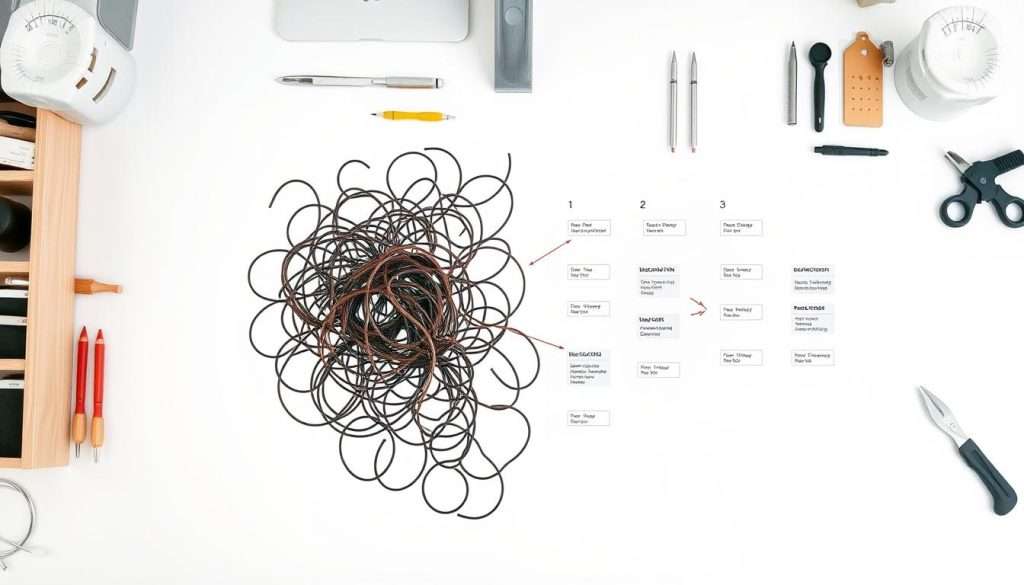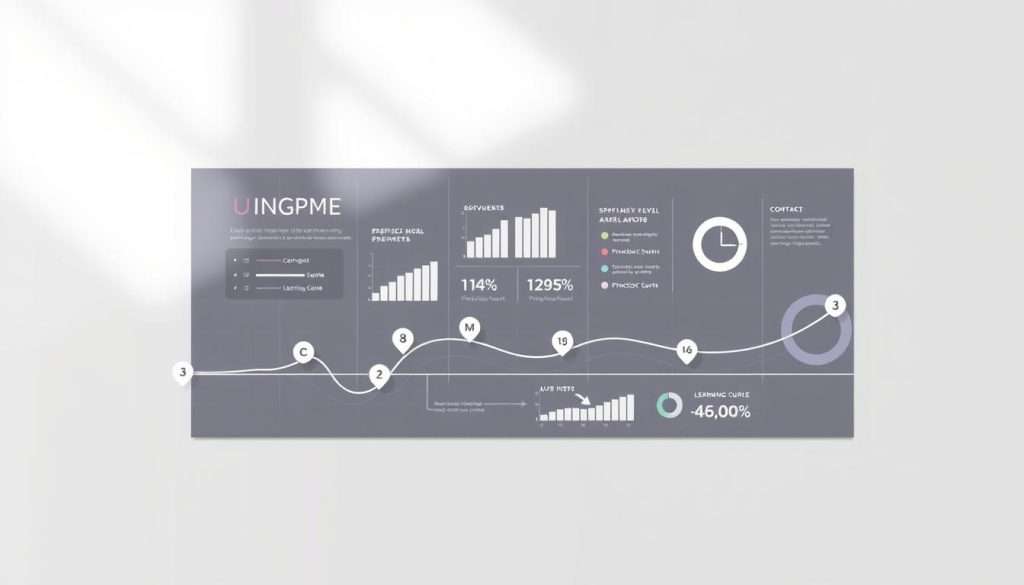Are you tired of feeling stuck in your career or personal growth journey? Do you wonder if there’s a more effective way to develop new skills and achieve your goals?
When it comes to growth at work, skill development is often the starting point. Whether you’re a new employee or a seasoned team leader, having the right mix of skills is crucial for adapting, advancing, and succeeding.
We believe that developing skills shouldn’t be a dreaded task. Our mission is to transform learning into an enjoyable, effective experience. In this article, we’ll explore practical skill development strategies to help you enhance your skills and achieve your goals.
Key Takeaways
- Understand the importance of strategic skill development
- Discover effective learning techniques to boost your skills
- Learn how to create a personalized skill development plan
- Find out how to stay motivated and track your progress
- Explore ways to overcome common obstacles in skill development
Understanding the Science of Skill Acquisition
The science of skill acquisition shows us how we learn. It’s key to know how we get better at things. Our brains can change and adapt, making it easier to learn new skills.
How Your Brain Builds New Neural Pathways
When we try something new, our brain makes new paths. This is called neuroplasticity. The more we do it, the stronger these paths get, helping us do it better.
The Myth of “Natural Talent” vs. Deliberate Practice
Research has proven that talent isn’t everything. It’s the hard work and focus that really matter. By practicing on purpose, we can master any skill.
Research-Backed Evidence on Skill Development
Studies prove that hard work beats talent. For example, a study on musicians showed that those who practiced the most were the best.
| Skill Development Factor | Deliberate Practice | Natural Talent |
|---|---|---|
| Effectiveness | High | Low |
| Improvement Rate | Rapid | Slow |
| Sustainability | Long-term | Short-term |
By understanding how we learn and focusing on hard work, we can get better at anything. This makes achieving our goals easier.
The Best Way to Build Any Skill: A Proven Framework
To master new skills, you need a clear plan. This plan is based on the 4-stage model of skill development. It guides you on your path to becoming an expert.
The 4-Stage Model of Skill Development
The 4-stage model helps you grow from unconscious incompetence to conscious competence and then to mastery. Knowing these stages is key to building skills well.
Unconscious Incompetence to Conscious Competence
First, you don’t know you lack a skill (unconscious incompetence). Then, you realize your weaknesses (conscious incompetence). With effort, you become skilled but still think about it (conscious competence). The last step is when the skill feels natural (unconscious competence).
Why Most People Fail at Skill Building
Many people struggle to get better at skills. This is because they face common obstacles. Knowing how to avoid these can help.
Common Pitfalls to Avoid
| Pitfall | Description | Solution |
|---|---|---|
| Lack of Clear Goals | Not defining what you want to achieve | Set SMART objectives |
| Insufficient Practice | Not dedicating enough time to deliberate practice | Create a practice schedule |
| Poor Feedback Mechanisms | Not receiving or acting on constructive feedback | Seek feedback from experts or mentors |
By knowing the 4-stage model and avoiding common mistakes, you can
Setting Clear and Actionable Skill Goals
Clear and actionable skill goals are key to learning new skills. They act as a roadmap for your learning journey. This helps you stay on track and motivated.
Defining Your “Minimum Viable Skill”
The “minimum viable skill” is the basic version of a skill that’s useful. Finding this skill helps you know what to focus on first. For example, learning a new language might start with basic conversations.
Creating SMART Skill Development Objectives
Make sure your skill goals are SMART: Specific, Measurable, Achievable, Relevant, and Time-bound. This makes your goals clear and reachable. For example, instead of “I want to be better at public speaking,” aim for “I will give a 5-minute presentation to my team in 3 weeks.”
Examples of Well-Crafted Skill Goals
Here are some examples of good skill goals:
- Learning a new song on the guitar in 2 months.
- Writing at least one article a month for a year to improve your writing.
- Enhancing coding skills by finishing a specific online course in 6 weeks.
These goals are clear, measurable, and have a deadline, making them easier to achieve.
Breaking Down Complex Skills into Manageable Components
Complex skills are like puzzles; to solve them, you need to break them down into their parts. When learning a new skill, it’s easy to feel overwhelmed. But, using skill deconstruction techniques can make learning easier and help you progress.
Skill Deconstruction Techniques
One powerful method for deconstructing complex skills is the DiSSS method. It stands for Deconstruction, Selection, Sequencing, and Stakes.
The DiSSS Method (Deconstruction, Selection, Sequencing, Stakes)
The DiSSS method involves:
- Deconstruction: Breaking down the skill into its fundamental components.
- Selection: Choosing the most important elements to focus on.
- Sequencing: Arranging these elements in an optimal learning order.
- Stakes: Creating an environment with appropriate consequences to motivate practice.
By applying the DiSSS method, you can transform a complex skill into a series of manageable tasks.
Identifying the 20% That Delivers 80% of Results
A crucial aspect of effective skill building is identifying the vital few actions that will generate the most significant results. This principle, known as the Pareto Principle, suggests that approximately 80% of results come from 20% of efforts.
| Skill Component | Importance Level | Effort Required |
|---|---|---|
| Core Technique | High | Significant |
| Advanced Variations | Medium | Moderate |
| Specialized Applications | Low | Minimal |
By focusing on the most critical components and eliminating or minimizing less important ones, you can achieve more with less effort.

Designing Your Optimal Practice Environment
To get better at new skills, you need a good learning space. Your practice area is key to improving. Make it the best it can be to master new skills.
Creating Distraction-Free Learning Spaces
Learning well means no distractions. Find what distracts you and remove it. For example, use headphones or a quiet room if you play music.
Set up your space with good lighting, comfy seats, and little clutter. This helps you focus and use your time wisely.
Tools and Resources That Accelerate Skill Development
The right tools and resources help a lot. What you need depends on the skill you’re learning.
Digital and Physical Tools for Different Skill Types
Digital skills need software and apps. Physical skills need equipment and props. Here are some examples:
| Skill Type | Digital Tools | Physical Tools |
|---|---|---|
| Language Learning | Duolingo, Babbel | Language textbooks, flashcards |
| Musical Instruments | MuseScore, Tuner apps | Guitar, piano, tuner |
| Coding | Visual Studio Code, GitHub | None |
Choosing the right tools speeds up your learning. This helps you reach your goals faster.
Implementing Deliberate Practice Strategies
Starting your journey to mastery means understanding deliberate practice. It’s a method to improve skills through focused practice. By using high-quality feedback and techniques like spaced repetition, you can improve your skills efficiently.
The Difference Between Practice and Deliberate Practice
Not all practice is the same. Regular practice keeps your skills sharp, but deliberate practice boosts them. The main difference is focus and intention. Deliberate practice pushes you out of your comfort zone and targets your weaknesses.
Designing High-Quality Feedback Loops
Feedback is key in deliberate practice. It shows where you need to get better and tracks your progress. There are two main types: self-assessment and feedback from others.
Self-Assessment vs. External Feedback
Self-assessment lets you judge your own work. External feedback comes from others, like coaches or peers. Both are important, and together they’re even better. Here’s why:
- Self-assessment sharpens your critical thinking and helps you know your strengths and weaknesses.
- External feedback offers a fresh view and spots things you might miss on your own.
Spaced Repetition and Interleaving Techniques
There are more ways to boost your practice. Spaced repetition and interleaving are two powerful ones. Spaced repetition reviews material at longer intervals to lock it in your memory. Interleaving mixes different skills or materials to improve applying what you’ve learned.
Using these methods in your practice will help you improve your skills efficiently. The secret to skill growth is being intentional and focused. Always challenge yourself to get better.
Overcoming Skill Development Plateaus
Skill development isn’t always a straight line. Sometimes, you’ll hit a plateau that needs a new approach. A plateau can be tough, but it’s a normal part of learning. By knowing how to spot and tackle these plateaus, you can keep moving forward.
Recognizing When You’ve Hit a Plateau
The first step is to know when you’ve hit a plateau. A plateau happens when you’re not improving, even with regular practice. It might be because you’re not being challenged enough, not getting enough feedback, or practicing the wrong way. To spot a plateau, keep track of your progress and be honest about how you’re doing.
Strategies to Break Through Performance Barriers
Once you’ve found your plateau, it’s time to find ways to get past it. A good strategy is to change how you practice. You could make your tasks harder or try a new method.
Micro-Adjustments and Technique Refinement
Small changes can make a big difference. Look closely at your current method and find ways to improve it. For example, if you’re playing an instrument, tweaking your finger placement or breath control can help a lot.
When to Seek Expert Guidance
While practicing on your own is important, sometimes you need help. If you’re stuck and don’t know how to move forward, think about getting advice from a coach or experienced person in your field. They can give you specific feedback, teach you new techniques, and help you solve specific problems.
As
“The greatest glory in living lies not in never falling, but in rising every time we fall.” – Nelson Mandela
, getting past plateaus is all part of the journey to becoming better. By recognizing plateaus, using the right strategies, and getting help when you need it, you’ll be on your way to reaching your skill goals.
Tracking Progress and Measuring Skill Development
Starting your skill-building journey? Knowing how to measure your progress is key to success. It’s vital to track your progress to reach your goals. Use good metrics and tracking systems to see how you’re doing and adjust as needed.
Effective Metrics for Different Skill Types
Each skill needs its own way to track progress. For example, learning a language might mean tracking vocabulary, grammar, and conversation skills. On the other hand, a sport might focus on speed, accuracy, and technique.
Quantitative vs. Qualitative Measurement
It’s important to look at both numbers and quality when tracking progress. Quantitative data gives you numbers, like how many words you’ve learned. Qualitative data shows the quality of your skills, like how well you perform or your technique.
Digital and Analog Progress Tracking Systems
There are many ways to track your progress, from digital apps to paper notebooks. Some popular digital tools include:
- Spreadsheets for tracking numbers
- Apps for specific skills, like languages or music
- Wearable devices for physical activity
Analog methods, like a practice journal or habit tracker, can also be very effective. The most important thing is to find a method that works for you and stick with it.

Building Skill Development Habits That Last
To improve skills efficiently, you need to build habits that stick. Developing lasting skill development habits is crucial for achieving long-term success in any area. By creating sustainable practice routines and leveraging strategic motivation, you can maintain your progress and continue growing.
Creating Sustainable Practice Routines
Establishing a consistent practice schedule is vital for skill development. Start by setting realistic goals and breaking them down into manageable chunks. This will help you stay focused and avoid burnout. For instance, dedicating 30 minutes each day to practice can be more effective than one long session per week.
Leveraging Habit Stacking and Environmental Triggers
Habit stacking involves building new habits onto existing ones. For example, if you already have a habit of drinking coffee every morning, you can stack a new habit of practicing a skill right after. Environmental triggers, such as placing your practice materials in a visible spot, can also help cue your new habits.
Maintaining Motivation During Skill Building
Motivation is a critical factor in skill development.
Intrinsic vs. Extrinsic Motivation Strategies
Intrinsic motivation comes from within, such as personal satisfaction, while extrinsic motivation is driven by external factors, like rewards or recognition. To maintain motivation, it’s essential to strike a balance between these two types. For example, setting personal challenges can foster intrinsic motivation, while sharing your progress with a friend can provide extrinsic motivation.
By combining these strategies and creating a supportive environment, you can build skill development habits that last and achieve your goals.
Conclusion: Your Roadmap to Mastery
Now that you know the best ways to build any skill, it’s time to start. Follow the strategies from this article to make a plan for yourself. This will help you reach your goals quickly and efficiently.
We talked about breaking down big skills into smaller parts. We also discussed creating the best practice space and using deliberate practice. These steps will help you get past skill development hurdles and see how far you’ve come.
Keep in mind, mastering any skill takes hard work and the right attitude. Use the methods we shared to move closer to success. You’ll make your learning journey much better.

